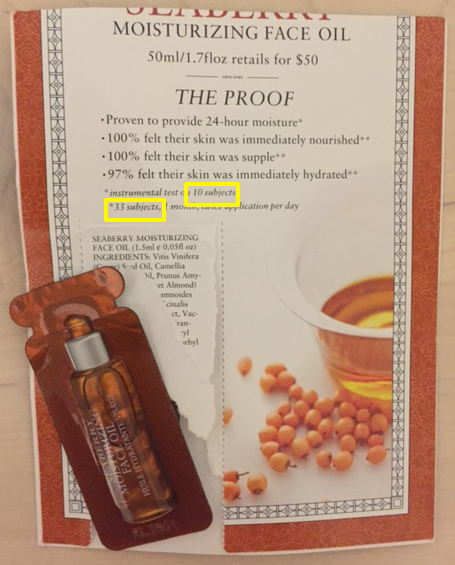Statistics in marketing materials...with a sample size of 10
As someone who used to do marketing in the beauty industry, I notice product messaging more so than the average consumer. I think that the “clinical claims” made by skincare brands can be pretty funny.
I got this sample of Fresh Seaberry Moisturizing Face Oil. I’m a fan of the product and brand, but check out the clinical claims on the package.
* 100% felt their skin was immediately nourished
* 100% felt their skin was supple
* 97% felt their skin was immediately hydrated

First, if 97% to 100% of people say they like your product, does the number even mean anything?
If you’re going to use large numbers, it'd be more believable to compare your skin before and after using the product. For example, “the sample size felt a 97% increase in hydration,” if that’s true.
Second, apparently 100% of people felt their skin was immediately more nourished and supple.
You know what else could fit that claim?
Smearing butter on your skin. Or applying any kind of lotion, oil, or moisturizer whatsoever.
Again, mentioning a before and after statistic would make more sense. Even better if you have the “before” as a normal moisturizer or another type of facial oil, and the “after” as your product, the Fresh Seaberry Oil.
Third, what’s up with the tiny sample size?
A sample size of ten is basically the brand manager, the associate manager, the intern, VP, and a few folks in product development. That’s ten people.
I get the desire to add beefiness to marketing claims. Showing the percentage of people who responded to skincare is certainly aimed at providing data behind claims that are hard to substantiate otherwise.
This is an interesting marketing challenge. Is offering clinical trial information the best way to convey legitimacy? I think it works for some brands and categories. Anything with OTC (over the counter) ingredients for acne or anti-aging tends to do well with offering clinical trial statistics.
If you’re going to go the clinical trial route, make the study appear robust and have a sample of bigger than 10 people.